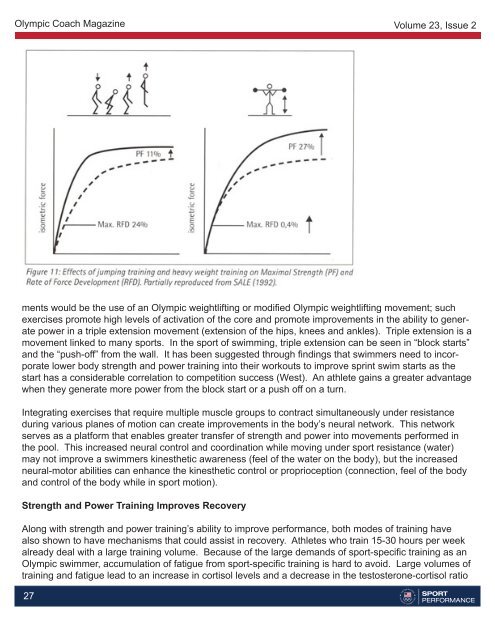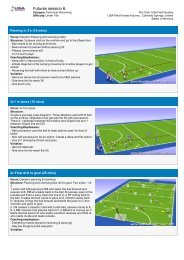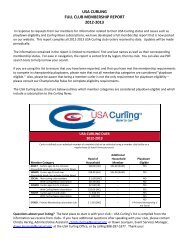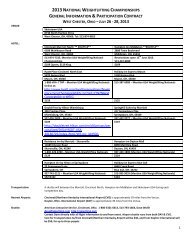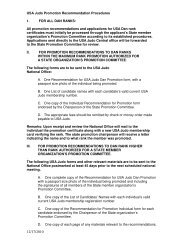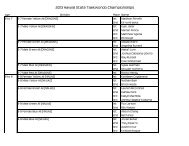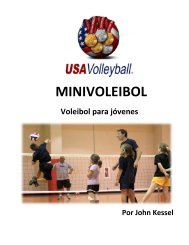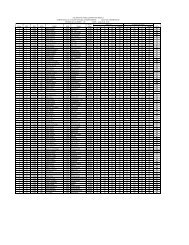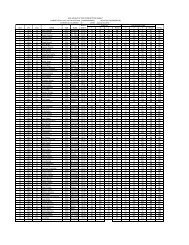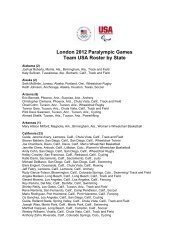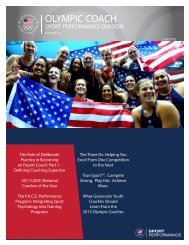Strength and Power for the Elite Swimmer 2012 - United States ...
Strength and Power for the Elite Swimmer 2012 - United States ...
Strength and Power for the Elite Swimmer 2012 - United States ...
Create successful ePaper yourself
Turn your PDF publications into a flip-book with our unique Google optimized e-Paper software.
Olympic Coach Magazine<br />
27<br />
Volume 23, Issue 2<br />
ments would be <strong>the</strong> use of an Olympic weightlifting or modified Olympic weightlifting movement; such<br />
exercises promote high levels of activation of <strong>the</strong> core <strong>and</strong> promote improvements in <strong>the</strong> ability to generate<br />
power in a triple extension movement (extension of <strong>the</strong> hips, knees <strong>and</strong> ankles). Triple extension is a<br />
movement linked to many sports. In <strong>the</strong> sport of swimming, triple extension can be seen in “block starts”<br />
<strong>and</strong> <strong>the</strong> “push-off” from <strong>the</strong> wall. It has been suggested through findings that swimmers need to incorporate<br />
lower body strength <strong>and</strong> power training into <strong>the</strong>ir workouts to improve sprint swim starts as <strong>the</strong><br />
start has a considerable correlation to competition success (West). An athlete gains a greater advantage<br />
when <strong>the</strong>y generate more power from <strong>the</strong> block start or a push off on a turn.<br />
Integrating exercises that require multiple muscle groups to contract simultaneously under resistance<br />
during various planes of motion can create improvements in <strong>the</strong> body’s neural network. This network<br />
serves as a plat<strong>for</strong>m that enables greater transfer of strength <strong>and</strong> power into movements per<strong>for</strong>med in<br />
<strong>the</strong> pool. This increased neural control <strong>and</strong> coordination while moving under sport resistance (water)<br />
may not improve a swimmers kines<strong>the</strong>tic awareness (feel of <strong>the</strong> water on <strong>the</strong> body), but <strong>the</strong> increased<br />
neural-motor abilities can enhance <strong>the</strong> kines<strong>the</strong>tic control or proprioception (connection, feel of <strong>the</strong> body<br />
<strong>and</strong> control of <strong>the</strong> body while in sport motion).<br />
<strong>Strength</strong> <strong>and</strong> <strong>Power</strong> Training Improves Recovery<br />
Along with strength <strong>and</strong> power training’s ability to improve per<strong>for</strong>mance, both modes of training have<br />
also shown to have mechanisms that could assist in recovery. Athletes who train 15-30 hours per week<br />
already deal with a large training volume. Because of <strong>the</strong> large dem<strong>and</strong>s of sport-specific training as an<br />
Olympic swimmer, accumulation of fatigue from sport-specific training is hard to avoid. Large volumes of<br />
training <strong>and</strong> fatigue lead to an increase in cortisol levels <strong>and</strong> a decrease in <strong>the</strong> testosterone-cortisol ratio


